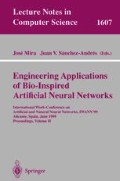Abstract
There are several approaches to quality control in industrial processes. This work is center in artificial vision applications for defect detection and its classification and control. In particular, we are center in textile fabric and the use of texture analysis for discrimination and classification. Most previous methods have limitations in accurate discrimination or complexity in time calculation; so we apply parallel and signal processing techniques. Our algorithm is divided in two phases: a first phase is the extraction of texture features and later we classify it. Texture features should have the followings properties: be invariant under the transformations of translation, rotation, and scaling; a good discriminating power; and take the non-stationary nature of texture account. In Our approach we use Orthogonal Associative Neural Networks to Texture identification and extraction of features with the previous properties. It is used in the feature extraction and classification phase (where its energy function is minimized) too, so all the method was applying to defect detection in textile fabric. Several experiments has been done comparing the proposed method with other paradigms. In response time and quality of response our proposal gets the best parameters.
Preview
Unable to display preview. Download preview PDF.
References
N.R. Pal and S.K. Pal, A review on image segmentation techniques, Pattern Recognition, Vol. 26, No.9, pp.1277–1294, 1993.
R.M. Haralick, Statistical and structural approaches to texture, Procc. IEEE, Vol. 67, pp. 786–804, 1979
C. Neubauer, Segmentation of defects in textile fabric, Procc. IEEE, pp. 688–691, 1992.
Hoggar, S. G. Mathematics for Computer Science. Cambridge University Press. 1993.
J.M.Zurada, Introduction to Artifial Neural Systems, West Publishing Company, 1992.
Harwaood, D. et al. Texture Classification by Center-Symmetric Auto-Correlation, using Kullback Discrimination of Distribution. Pattern Recognition Letters. Vol 16, pp. 1–10. 1995.
Laws, K. Y. Texture Image Segmentation. Ph D. Thesis. University of Southern California. January. 1980.
Francisco Ibarra Picó. Análisis de Texturas mediante Coeficiente Morfológico. Modelado Conexionista Aplicado. Ph. D. Thesis. Universidad de Alicante. 1995.
Garcia-Chamizo J.M., Crespo-Llorente A. (1992) “Orthonormalized Associative Memories”. Proceeding of the IJCNN, Baltimore, vol 1, pg. 476–481.
Hao J., Wanderwalle J. (1992) “A new model of neural associative memoriy” Proceedings of the JJCNN92, vol 2, pg. 166–171.
Hopfield J.J. (1984a) “Neural Networks and physical systems with emergent collective computational abilities”. Proceedings of the National Academy of Science, vol 79, pg. 2554–2558.
Hopfield J.J. (1984b) “Neural networks with graded response have collective Computational properties like those of two-state Neurons”. Proceedings of the National Academy of Science, vol 81, pg. 3088–3092.
Ibarra-Picó F., Garcia-Chamizo J.M. (1993) “Bidirectional Associative Orthonormalized Memories”. Actas AEPIA, vol 1, pg 20–30.
Kosko, B. (1988a) “Bidirectional Associative Memories”. IEEE Tans. on Systems, Man & Cybernetics, vol 18.
Kosko, B. (1988b), “Competitive adaptative bidirectional associative memories”. Proceedings of the IEEE first International Conference on Neural Networks, eds M. Cardill and C. Butter vol 2. pp 759–766.
Pao You-Han. (1989) “Adaptative Pattern Recognition and Neural Networks”. Addison-Wesley Publishing Company, Inc. pg 144–148.
Wang, Cruz F.J., Mulligan (1990a) “On Multiple Training for Bidirectional Associative Memory”. IEEE Tans. on Neural Networks, 1(5) pg 275–276.
Wang, Cruz F.J., Mulligan. (1990b) “Two Coding Strategies for Bidirectional Associative Memory”, IEEE Trans. on Neural Networks, pg 81–92.ang, Cruz F.J.
Author information
Authors and Affiliations
Editor information
Rights and permissions
Copyright information
© 1999 Springer-Verlag Berlin Heidelberg
About this paper
Cite this paper
Ibarra Pico, F., Cuenca Asensi, S., Carcía-Chamizo, J.M. (1999). Feature extraction with an associative neural network and its application in industrial quality control. In: Mira, J., Sánchez-Andrés, J.V. (eds) Engineering Applications of Bio-Inspired Artificial Neural Networks. IWANN 1999. Lecture Notes in Computer Science, vol 1607. Springer, Berlin, Heidelberg . https://doi.org/10.1007/BFb0100513
Download citation
DOI: https://doi.org/10.1007/BFb0100513
Published:
Publisher Name: Springer, Berlin, Heidelberg
Print ISBN: 978-3-540-66068-2
Online ISBN: 978-3-540-48772-2
eBook Packages: Springer Book Archive

